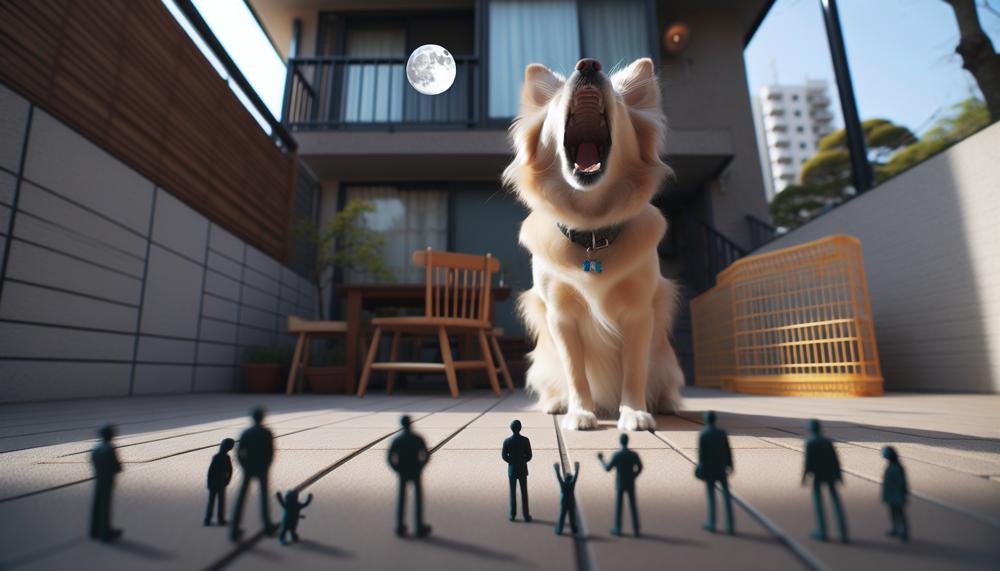Imagine this: you’re taking a leisurely stroll through the park, enjoying the warm sun and fresh air, when suddenly a dog starts barking at you. Your heart races as you freeze, unsure of how to react as the dog continues to growl and bark. Do you run away in fear? Attempt to calm the dog down with soothing words? Or simply ignore it and hope for the best?
If you’re a dog owner or lover, this scenario may sound all too familiar. We’ve all experienced that uneasy moment when a seemingly friendly dog transforms into a fierce protector at the sight of certain individuals. But have you ever stopped to wonder why some dogs bark at certain people while others don’t even bat an eye?
In this thought-provoking blog post, we’ll delve into the captivating world of canine behavior and explore the reasons behind why dogs bark at certain people. From primal instincts to learned behaviors, there are numerous factors that contribute to this intriguing phenomenon.
So, let’s start.
Why Do Dogs Bark At Certin People?
Table of Contents
- 1 Why Do Dogs Bark At Certin People?
- 2 The Role of Fear and Anxiety in Barking at Certain People
- 3 Territorial Behavior: Why Dogs Bark at Intruders
- 4 The Importance of Socialization in Preventing Barking at Certain People
- 5 Human Body Language and Its Impact on Dog Behavior
- 6 How to Address Barking at Certain People through Training and Positive Reinforcement
- 7 When to Seek Professional Help for Excessive Barking
- 8 Conclusion
| Why Do Dogs Bark At Certain People? | Explanation |
| Possible Causes of Barking | Dogs communicate through barking, and there are various reasons why they may bark at specific individuals. These include fear, anxiety, territorial behavior, lack of socialization, and perception of threat. |
| Fear or Anxiety | Dogs may bark at people who seem intimidating or resemble someone who has mistreated them in the past. This behavior is a way for them to express their fear or anxiety towards the person. |
| Territorial Behavior | Dogs are natural protectors, and they may bark at strangers who enter their territory, such as their home or yard. This behavior is their way of guarding their owners and space. |
| Lack of Socialization | If a dog has not been exposed to a variety of people during its critical socialization period, they may become fearful or anxious around unfamiliar individuals. This can lead to barking as a way to communicate their discomfort. |
| Perception of Threat | Dogs are highly perceptive of human emotions, and they may bark at people who display nervousness, fear, excitement, or aggression. This behavior is their way of expressing their reaction towards the person’s emotions. |
The Role of Fear and Anxiety in Barking at Certain People

Our canine companions are highly sensitive creatures, picking up easily on our emotions and body language. As such, fear and anxiety can have a significant impact on a dog’s tendency to bark at certain people. This behavior is often triggered by past negative experiences or improper socialization.
Dogs may resort to barking as a means of expressing their fear or anxiety towards a specific person or situation. This can occur if the dog senses similar emotions from their owner towards the individual in question. In these cases, the dog may imitate their owner’s behavior and react with fear or anxiety, resulting in excessive barking as a form of protection.
Furthermore, if a dog has had negative interactions with a particular person, it may develop fear or anxiety towards that individual. This can lead to incessant barking as the dog attempts to keep that person away.
Lack of proper socialization can also contribute to a dog’s fear and anxiety towards certain people. Dogs who have not been exposed to diverse individuals and situations may become fearful and anxious in unfamiliar settings, leading to barking as a form of self-defense.
It’s crucial for dog owners to understand that using fear-based training methods, such as shock collars or prong collars, is not recommended by leading animal welfare organizations like Best Friends Animal Society and the ASPCA. These methods can worsen a dog’s fear and anxiety, resulting in even more excessive barking.
Instead, it’s important to address the root cause of the fear and anxiety through positive reinforcement training techniques. This involves creating positive associations with the trigger through rewards, such as treats or toys, and gradually desensitizing the dog to the trigger.
Territorial Behavior: Why Dogs Bark at Intruders
Dogs have a strong instinct for territorial behavior, which can lead them to bark at specific individuals as a way to declare and defend their space from potential intruders. Often, dogs see unfamiliar people as potential threats and will bark to alert their owners and dissuade the perceived intruder. This ingrained behavior can also be observed in wild canines.
However, several factors can influence a dog’s response towards certain individuals, including past experiences, inadequate socialization, and reinforcement from their owner.
Furthermore, research has shown that lack of socialization during a dog’s early years can contribute to their tendency to bark at unfamiliar individuals. Dogs that are not exposed to different people and situations during their critical socialization period may see anyone outside their immediate circle as an intruder and respond accordingly.
It is essential to note that a dog’s reaction towards certain individuals can also be influenced by their past experiences. For example, if a dog has been mistreated or abused by someone in the past, they may develop a fear or aggression towards similar individuals.
It is crucial for owners to understand their dog’s history and address any potential traumas through proper training and socialization.
The Importance of Socialization in Preventing Barking at Certain People
Socialization is a critical aspect of a canine’s development that teaches them how to interact with various individuals, animals, and surroundings. It involves gradually exposing them to diverse experiences in a positive and controlled manner, building their confidence and adaptability.
Proper socialization plays an essential role in preventing dogs from barking at specific individuals by making them feel comfortable and less afraid in new situations. When a dog is well-socialized, they are less likely to perceive someone as a threat and resort to excessive barking as a defense mechanism.
Through socialization, canines can effectively communicate without relying solely on barking. They become accustomed to different sights, sounds, and smells, making them less likely to be overstimulated and bark excessively.
If a dog continues to show severe anxiety or aggression towards certain people despite efforts to socialize them, it may be necessary to seek help from a professional trainer or behaviorist.
It is essential to start socializing dogs at a young age between three to twelve weeks old. However, older dogs can also be socialized with patience and gradual introduction to new experiences.
While well-socialized dogs are generally safe around children, supervision is still recommended.
Additionally, even if a dog is well-socialized, laws and regulations may require them to be kept on a leash in public places.
Human Body Language and Its Impact on Dog Behavior
The impact of a person’s body language on a dog’s behavior cannot be underestimated. Unlike humans, dogs primarily rely on body language and vocalizations to communicate, making it crucial to understand and respect their non-verbal cues.
A dog’s response to a person’s body language can vary greatly depending on how the person carries themselves, their facial expressions, and their movements. For instance, a person with tense body language, a stiff posture, and direct eye contact may be perceived as a threat by the dog, leading to barking or other aggressive behaviors.
Moreover, dogs are highly perceptive of human behavior and can sense when someone is agitated or stressed. This can cause the dog to become anxious and bark as a way to release tension. In some cases, dogs may even bark at people who exhibit similar body language to those who have caused them harm in the past, due to a learned response.
Hence, it is crucial for both dog owners and non-dog owners to be mindful of their body language when interacting with dogs. Being aware of how dogs communicate through body language can help prevent unwanted behaviors like excessive barking. Proper socialization and positive reinforcement are also essential in helping dogs feel more comfortable and confident in various situations.
How to Address Barking at Certain People through Training and Positive Reinforcement
Positive reinforcement and training are powerful techniques that can effectively address a dog’s tendency to bark at certain people. Here are some methods that can be utilized to achieve this goal:
| 1. | Teach “Speak” and “Quiet” commands: | By training your dog to understand the “Speak” and “Quiet” commands, you can have more control over their barking behavior. When your dog starts barking at a particular person, you can use the “Quiet” command to stop them from barking. With consistent training, they will learn to associate the command with being quiet and will eventually stop barking on command. |
| 2. | Positive reinforcement training: | Using treats or praise as positive reinforcement can be highly effective in training your dog to stop barking. When your dog is calm and not barking at certain people, reward them with treats or praise. This will reinforce the desired behavior and encourage them to continue behaving calmly. |
| 3. | Ignore the behavior: | One effective technique is to ignore your dog when they start barking at certain people. Dogs often bark for attention, so by not rewarding their behavior with attention, you can discourage them from barking. Once they stop barking, you can give them attention and praise, reinforcing the desired behavior of being quiet. |
| 4. | Minimize triggers: | If you know what triggers your dog to bark at certain people, try to minimize it as much as possible. For example, if your dog barks at people walking by your house, close the curtains or move them to a different room where they cannot see outside. This will help reduce their barking behavior. |
| 5. | Desensitization training: | Gradually exposing your dog to the triggers that make them bark, and rewarding them for remaining calm, can help desensitize them to those triggers. For example, if your dog barks at people wearing hats, start by showing them pictures of people wearing hats and rewarding them for remaining calm. Then gradually move on to seeing people wearing hats in person. |
In addition to these techniques, providing your dog with environmental enrichment is crucial in keeping them occupied and reducing their overall anxiety levels. This can include giving them toys and engaging activities, using calming aids such as pheromone sprays or soothing music, and playing background noise to mask outside sounds.
Remember, each dog is unique, and it may take time and patience to address their barking behavior.
When to Seek Professional Help for Excessive Barking
In some cases, the barking may persist despite attempts at training, indicating the need for outside help. Seeking professional assistance early on can prevent the issue from escalating and improve the overall well-being of both you and your dog.
But when should you seek professional help for your dog’s excessive barking? Well, it’s not always easy to tell. That’s why it’s crucial to pay close attention to your dog’s behavior and seek help as soon as you notice any concerning signs. For example, if your dog’s barking is causing problems for you or your neighbors, it’s important to address the issue before it escalates further.
Additionally, if the barking is accompanied by other behavioral issues, it may be a sign of an underlying problem that requires professional intervention.
Furthermore, if there doesn’t seem to be any trigger for the barking and your attempts at training have been unsuccessful, seeking professional help can provide valuable insights into the root cause of this behavior.
Remember that excessive barking is not just a nuisance but can also be a sign of stress or discomfort for your beloved pet. Early intervention can prevent further distress and improve your dog’s overall well-being.
Conclusion
To sum up, there are various reasons why dogs may bark at certain people. It could be due to fear, anxiety, territorial behavior, or lack of socialization. Understanding these underlying factors is crucial in effectively addressing the issue through proper training and positive reinforcement.
By being mindful of our body language and providing environmental enrichment, we can help prevent excessive barking in our furry companions. However, if the barking persists despite our efforts, seeking professional help is highly recommended to address any underlying issues and improve the overall well-being of our beloved pets.
Always remember to approach this behavior with patience and understanding as you work together with your dog towards a solution.






